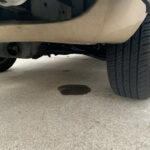Introduction
Power steering fluid is important to the functioning of the power steering system and the overall health of your car. It helps to transmit the power in the steering system, allowing you to turn effortlessly. The causes of power steering leak, the safety of driving with a leaking power steering, and related dangers are discussed below:
Potential Causes of Power Steering Leak

Driving And Style said, There can be various sources of power steering leak. Some of the most common causes of a power steering leak are as follows:
Power Steering Pump
One of the most common reasons for a power steering leak is the power steering pump. The leakage from the pump occurs due to the worn seal around the pump shaft. In some cases, the pump itself can be the cause of the leak. When the pump creates pressure, it can break the pump’s casing. Most power steering pumps consist of two bolting halves. Hence, a broken casing will cause the power steering fluid to leak. The joint gasket can also cause the leak if it is old or loose.
Hydro Boost Brakes
You can also check for power steering fluid in hydro-boost brakes. Though it is a rare cause of power steering leak, you should check it to be sure of the leakage source. Some cars can have the power steering and hydro-boost brakes linked. Hence, a loss of power steering can affect the brakes too. Many multiple hoses and valves divide the power between these systems. You must check the seals and gaskets in each of these hoses that can be a potential reason for power steering fluid leaks.
Power Steering Hoses
The most common and likely source of power steering fluid leak is the power steering hoses. A typical power steering system consists of a pressure hose and a return hose. The pressure hose extends from the steering box to the power steering pump. The return hose runs from the gearbox to the reservoir. With wear and tear, the hoses can get cracked and damaged. This can cause the power steering leak. This can also cause a disconnection between steering system components and the hoses.
Can You Drive with a Power Steering Leak?
Technically you can drive with a power steering leak. If there is power steering fluid still left, you can cover many miles with it. However, the situation can become potentially dangerous once the entire power steering fluid is drained out. If you have spare steering fluid with you, keep filling it with every few miles you drive. 14 ounces of steering fluid can be added to the pump for driving nearly 400 miles. Monitoring the level of power steering fluid in such cases becomes important. If not monitored, the pump can become completely dry which can damage it.
Once the pump is completely dry, it can get damaged easily. In most cases, you may find it difficult to drive past 100 miles with a dry pump. Without any power steering fluid, the pump and steering rack can get overheated quicker. This can also increase the friction and cause severe damage to the pump and power steering rack. If you continue driving in this condition, the head gasket can also break down.
Dangers of Driving with a Power Steering Leak
Though you can continue to drive with a power steering leak, it should not be done regularly. You must identify the cause of the leak and get it repaired immediately. You can experience the following while driving with a power steering leak:
Loss of Power Brakes
Each car model is different. In some cars, a loss of power steering may also result in loss of power brakes. Though the brakes will continue to work, you will have to apply a lot more force for them to deliver. This can become dangerous as the braking capabilities of the car may be compromised. You may be unable to apply brakes and bring your car to a halt immediately. This can be detrimental to your road safety. It can also be dangerous for others on the road.
Pump Damage
If your power steering fluid runs out, you can continue driving your car without the power steering. However, this can damage the pump. Once the power steering fluid completely runs out, it can drain the pump dry. This will cause increased friction and overheating that can easily damage the pump. If ignored, this can lead to severe damage to the pump and other parts that can be costly to get fixed. While driving with leaking power steering, you should be careful and avoid taking sharp turns.
Loss of Control
Power steering makes it easier for you to control and maneuver your car. You can depend on power steering to provide you a comfortable ride quality and handling. A leaking power steering will be compromised and unable to deliver its functions as desired. You can experience a loss of control while driving with a leaking power steering. This can make your car underpowered and sluggish. This sluggishness becomes more pronounced at low speeds and makes it tougher to control the car.
Overheating
Power steering fluid acts as a coolant for the steering system and keeps it cool. If it goes below the prescribed limit due to a leak, you may experience overheating of the steering system. This will cause the power steering pump or the steering rack to overheat. Overheating can damage both the power steering pump and the steering rack. If your car’s steering rack is damaged, it can cost $1,000 or more to get it repaired. Thus, you should regularly check the power steering fluid levels to ensure the steering system works perfectly and is not prone to overheating and related damages.
Conclusion
Power steering fluid plays a key role in keeping the power steering system running smoothly. It can improve the ride quality and maneuverability of your car. You can continue to drive with a leaking power steering. However, it should not be practiced regularly. A leaking power steering can also damage the pump, cause overheating, and make your car feel underpowered. Regular checking of the power steering fluid helps you to prevent its leak and related problems.








